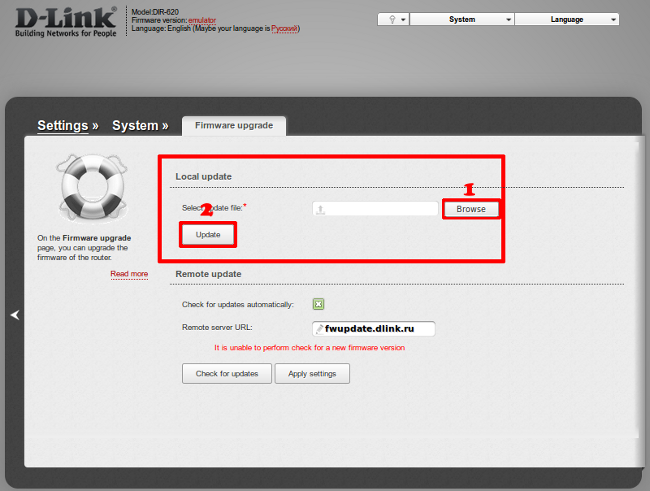D Link Dsl 2640u T1 Firmware Update
понедельник 14 января admin 80
Jun 30, 2012 d-link dsl 2640u h/w: t1 f/w: me_1.00 I have searched for that firmware EVERYWHERE. The last place you want to look at is paradoxically on the D-Link websites.
WARNING - PLEASE READ BEFOREUPGRADE: Upgrading firmware (in most cases) will reset all settings backto defaults. This includes the login passwords, the IP address andInternet connection settings provided by your ISP. Please ensureyou have backed this information up before proceeding. We recommend performing a reset to factory defaults after anyfirmware upgrade to avoid conflicts with prior configurations.
Do NOT upgrade firmware from a computerconnected wirelessly. Use a computer that connects to the routerusing an Ethernet cable. You may cause the router to becomeinoperable due to the wireless connection dropping while theupgrade is in process. To upgrade the firmware of your router, you will first need todownload the required files from the D-Link Support page for thisrouter. After saving it to a local storage device (e.g. Harddrive),you will have to unzip the file. Once this is done, log in to the web configuration interface, goto the TOOLS or MAINTENANCE tab and click on the UPDATE FIRMWARE button on theleft-hand side.
Click on Browse, browse to andselect the file that you saved before, then click on Update Firmware or Firmware. The router will then copy the new firmware into its memory andperform the update, after which it will reboot. This will takeapproximately three minutes.
Hello, I've been given that modem and was very interested in repairing it. It is 'bricked' I think. All it does is blink. Resetting it doesn't do anything. I searched for its firmware everywhere. I mean even D-Link doesn't have the file for that particular hardware version (T1), the others can be found no problem. I opened the thing.
Casing: Model: DSL-2640U FCC ID: KA2SL2640BT1 P/N: ISL2649UEME3.T1E H/W: T1 F/W: ME_1.00 Inside box, on PCB: 3990/S1/V1.00/D-Link/Gaw5.6 T02A-4(dying gasp)Russia/Gaw 5.6T02-4-DL-R1B010-ME.EN PCB: Chips: - BROADCOM: -BROADCOM BCM5325EKQMG n RG1030 P11 n 1000410 1A: Six port managed 10/100 ROBOswitch.  -BROADCOM BCM6333KFBG n HG1041 P12 n 101123 01: SINGLE CHIP ADSL TO ETHERNET CPE ROUTER -BROADCOM BCM4312KF86 n TK1034 P11 n 993752 82 - ESMT: -M12L128168A- 7T n AZT1E070G 1028 - MNC: -MNC H2001DG n 1040 I learned that Dying Gasp is a signal the router sends to the ISP when there is a current outage to tell him 'The connection will be dropped, it's not because there's a bad link. It's because the power is down'. It does that with some juice stored in capacitors. And it sends three messages, I think. I discovered something interesting too.
-BROADCOM BCM6333KFBG n HG1041 P12 n 101123 01: SINGLE CHIP ADSL TO ETHERNET CPE ROUTER -BROADCOM BCM4312KF86 n TK1034 P11 n 993752 82 - ESMT: -M12L128168A- 7T n AZT1E070G 1028 - MNC: -MNC H2001DG n 1040 I learned that Dying Gasp is a signal the router sends to the ISP when there is a current outage to tell him 'The connection will be dropped, it's not because there's a bad link. It's because the power is down'. It does that with some juice stored in capacitors. And it sends three messages, I think. I discovered something interesting too.
The device has a Serial Port to talk to me Looking further, it seems it's a 3.3 volts, and it needs to be level shifted. Anyway, but for now. I wanted to have the firmware.
So I downloaded many, and by accident, one had a filename in the form of gaw5.6t02-4-dl-r1b030 So I searched for 'gaw5.6t02-4-dl-r1b010' and luckily, I found The file can be downloaded here: D-Link has messy web-sites, not accessible I do not know why. So now, I have to set up something in order to communicate with the box. The web interface doesn't work, obviously.
And I think the firmware image has been corrupted. Maybe it won't even be able to talk to me, and I'll have to dump something in the nvram and whatnot.
Concerning the interface with the PC, etc. I also discovered a great program, it's called Flashrom. It's from programming chips (Firmware hubs, etc.). Update 0x1: I tried to communicate with the router with my PICkit2 ICSP ports. Microman was kind enough to speed the process with the pinout and raising morale. The thing is that the Broadcom chip communicates at a staggering baudrate (115200 baud). When I use the PICKit2 software, the maximum is 34800 baud.
So you see the hic. The good thing is that the voltage can be chosen to 3.3 volts. I'm thinking to use some PIC (the 16F887 which has an enhanced USART). Birki na protivogaz obrazec e. I have seen that it has the autodetect feature for baudrate, and I have seen the 115200 mentioned in its datasheet.
